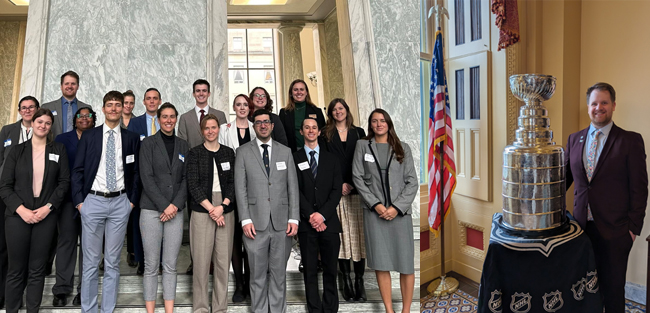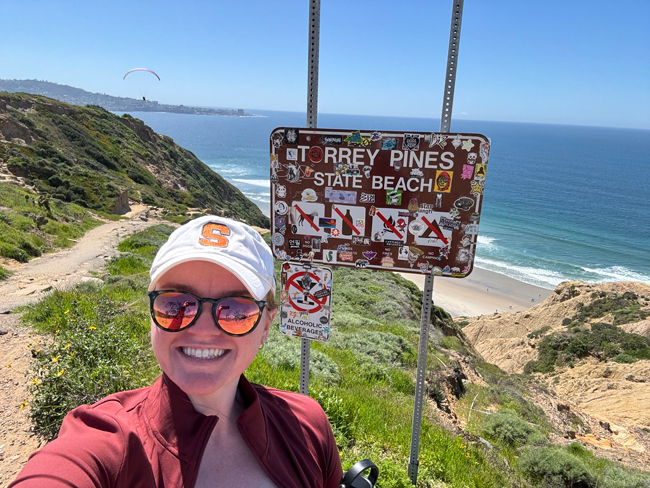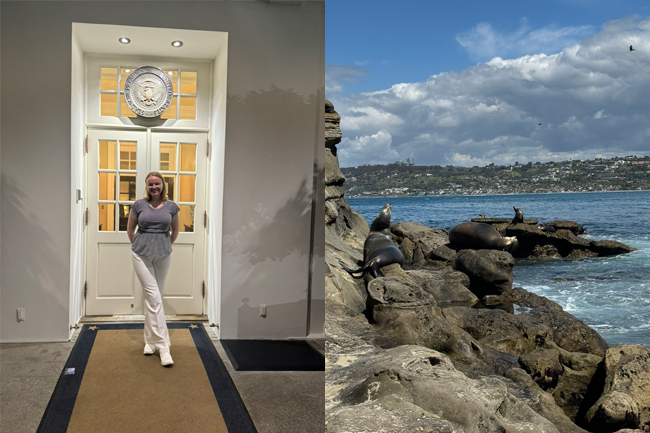— By Chris Gonzales, Freelance Science Writer, New York Sea Grant
Stony Brook, NY, January 20, 2025 - The 46th class of Knauss Fellowship finalists are set to start on February 1st. In honor of the occasion, we reached out to NYSG's 2024 Knauss fellows — Patrick Shea, Brianna Grimes, and Maximilian Brown — and collected these updates, in their own words, as their year-long fellowships come to a close ...
Patrick Shea
Legislative Fellow, Sea Grant's John A. Knauss Marine Policy Fellowship
Office of Senator Tammy Baldwin of Wisconsin
“This fellowship has been equal parts enjoyable, exciting, and eye-opening,” says Shea. “Working in the legislative branch has given me first-hand knowledge of how laws and policies not only incorporate the science conducted across sectors in society, but also how they advance through the hard work of those advocating for the needs and well-being of the American public.”
“The breadth of topics I contribute to in my office—centered on the environment, energy, and agriculture, among others—have provided an unparalleled opportunity for growth,” he adds. “As part of my fellowship, I took a trip throughout the state of Wisconsin, meeting with groups to see the great work they’ve accomplished and to discuss how my office could support their significant contributions. While I have undoubtedly developed into a more well-rounded scientist, perhaps the greatest but least expected benefit has been the more engaged citizen this experience has allowed me to become.”

(At left) All of this year's Knauss legislative fellows gather in the Foyer of the Rayburn House Office Building, after their placement week. Shea is at the top-left. Credit: National Sea Grant College Program; (At right) Shea poses with the Stanley Cup trophy, which was brought to the Capitol for display, giving Hill staffers an opportunity to go see and take pictures with it. Credit: Patrick Shea
Brianna Grimes
Executive Fellow, Sea Grant's John A. Knauss Marine Policy Fellowship
Marine Mammal Commission
“I was placed at the Marine Mammal Commission,” says Grimes, “a small, independent federal agency that provides science-based oversight of domestic and international policies and actions of federal agencies addressing human impacts on marine mammals and their ecosystems. My primary goals for my fellowship year were to learn more about working at a federal agency and gain exposure to congressional affairs and the legislative process. Fortunately for me, the Commission has enabled me to do both!”
“In my role,” she adds, “I assist with the Commission’s congressional affairs and broader public communication strategies. In my day-to-day work, I often have meetings with Hill staffers, collaborate with other Commission staff to create forward-facing outreach materials (like informational factsheets), and assist in writing letters to other federal agencies regarding their marine mammal related activities. In March I traveled to La Jolla, California for the Pacific Scientific Review Group meeting—allowing me to dive into the science side of the Commission’s work.”

At Torrey Pines in La Jolla, California, Grimes surveys the view while taking a break during the Pacific Scientific Review Group meeting. Credit: Brianna Grimes

(At left) Grimes takes a White House West Wing tour. She was a guest of the White House Office of Science and Technology Policy Fellow. Credit: Kirsten Williams; (At right) Grimes glimpsed sea lions on the beach in La Jolla. Credit: Brianna Grimes

Grimes (center) appears with two other fellows (Kirsten Williams, at left, and Tricia Light, at right) in the Eisenhower Executive Office Building. Credit: Brianna Grimes
Maximilian Brown
Executive Fellow, Sea Grant's John A. Knauss Marine Policy Fellowship
NOAA's National Ocean Service, National Centers for Coastal Ocean Science
“I'm quite enjoying my role at the National Centers for Coastal Ocean Sciences (NCCOS) as a policy analyst and communicator,” says Brown. “My job is to communicate to Congress (and the public) the science being done at NCCOS. My portfolio right now is focused on Offshore Wind (OSW) and Marine Spatial Planning congressional engagement. I have presented at a number of OSW briefings and have been fortunate enough to participate in many other briefings in other areas related to NCCOS science. Congressional engagement, in addition to setting up meetings with staffers, also involves writing email updates to detail the science NCCOS is working on.”
“I also work on NOAA-wide Sargassum Policy and have been writing a document that will be externally-facing when completed,” he adds. “I have written a number of NCCOS news items and social media posts. I am the National Ocean Services (NOS) science board administrative coordinator. I have attended a number of conferences and was just aboard the NOAA Pisces on a research expedition. I am on the Knauss Publications committee and the social committee.”

(At left) Max Brown collects water samples on the Long Island Sound at a shore site in Calf Pasture, CT. Credit: Max Brown; (At right) Portrait of Max Brown. Credit: Hallee Meltzer, NOAA Sea Grant
More Info: New York Sea Grant
Established in 1966, the National Oceanic and Atmospheric Administration (NOAA)’s National Sea Grant College Program promotes the informed stewardship of coastal resources in 34 joint federal/state university-based programs in every U.S. coastal state (marine and Great Lakes) and Puerto Rico. The Sea Grant model has also inspired similar projects in the Pacific region, Korea and Indonesia.
Since 1971, New York Sea Grant (NYSG) has represented a statewide network of integrated research, education and extension services promoting coastal community economic vitality, environmental sustainability and citizen awareness and understanding about the State’s marine and Great Lakes resources.
NYSG historically leverages on average a 3 to 6-fold return on each invested federal dollar, annually. We benefit from this, as these resources are invested in Sea Grant staff and their work in communities right here in New York.
Through NYSG’s efforts, the combined talents of university scientists and extension specialists help develop and transfer science-based information to many coastal user groups—businesses and industries, federal, state and local government decision-makers and agency managers, educators, the media and the interested public.
New York Sea Grant, one of the largest of the state Sea Grant programs, is a cooperative program of the State University of New York (SUNY) and Cornell University. The program maintains Great Lakes offices at Cornell University, SUNY Buffalo, Rochester Institute of Technology, SUNY Oswego, the Wayne County Cooperative Extension office in Newark, and in Watertown. In the State's marine waters, NYSG has offices at Stony Brook University and with Cornell Cooperative Extension of Nassau County on Long Island, in Queens, at Brooklyn College, with Cornell Cooperative Extension in NYC, in Bronx, with Cornell Cooperative Extension of Ulster County in Kingston, and with Cornell Cooperative Extension of Westchester County in Elmsford.
For updates on Sea Grant activities: www.nyseagrant.org, follow us on social media (Facebook, Twitter/X, Instagram, Bluesky, LinkedIn, and YouTube). NYSG offers a free e-list sign up via www.nyseagrant.org/nycoastlines for its flagship publication, NY Coastlines/Currents, which it publishes 2-3 times a year.